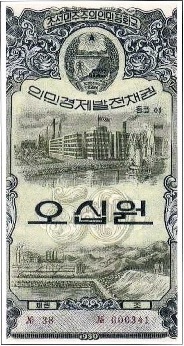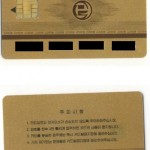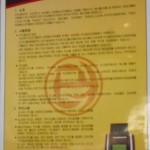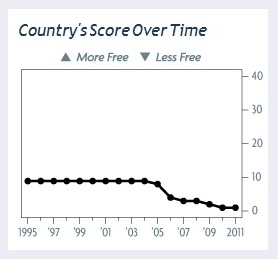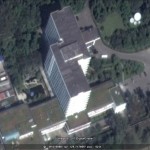Pictured above: An annual index measure of economic freedom in the DPRK from 1995 to 2011, published by the Heritage Foundation’s and Wall Street Journal’s Index of Economic Freedom.
[The] Heritage foundation and the Wall Street Journal recently published a new edition of their annual index of economic freedom, according to which North Korea has the world’s least-free economy. One can hardly argue about this – North Korea has for decades worked hard to take Stalinism to its logical extremes, and slightly beyond that.
However, one gets perplexed when looking at the grades of unfreedom that are given by the Heritage Foundation to the North through the 1995-2011 period. According to the index, the level of economic unfreedom in North Korea was essentially the same throughout the entire 1996-2005 period. Then, in 2005 it deteriorated considerably and has continued a slow downward slide until now.
This depiction is bound to raise the eyebrows of anyone who is familiar with actual economic trends in North Korea. The graph is correct when it says that the economy became more restrictive in 2005, when the government tried to re-introduce the rationing and reconfirmed the ban on the private sale of grain (such a ban had existed since 1957, but ceased to be enforced around 1990).
However, the 2005 measures were, essentially, a backlash, an attempt to reverse the half-baked reforms of 2002 – and those reforms can be described only as liberalizing.
On balance, the 2002 reforms should not be overestimated. Nonetheless, the 2002 reforms legalized a significant part of the black economy, and also granted managers of state-owned industrial enterprises a measure of managerial freedom they had not had for many decades.
If this was not an increase in economic freedom, what was it? But the Heritage Foundation graph does not give any hint of this change: the line that purports to depict the level of economic freedom remains on the same low level in 2002.
This is more interesting because 1997-2002 was when actual economic freedom increased dramatically. The old hyper-Stalinist laws remained technically effective, but nobody bothered to enforce these restrictions. It is estimated that in the early 2000s, the average North Korean family drew some 80% of its income from various market activities.
This was technically illegal, but the authorities were ready to turn a blind eye to the re-emergence of some form of a market economy, and in 2002 they even grudgingly and partially legalized the already flourishing market economy.
However, these improvements – both de-facto and, in 2002-2005 de-jure – find no expression in the flat line of the Heritage graph which, however, does not fail to notice that after 2005 the situation again began to deteriorate due to a government backlash against the private economy. The backlash was not particularly successful, but it lasted until 2009, and this is correctly reflected by the downward line at the graph.
However, then the graph begins seriously misleading again – and again, seemingly due the same implicit assumption that in North Korea things can go only from bad to worse. The graph depicts 2009 as a year when the level of freedom went even lower – and this is a correct assumption, since in 2009 the authorities undertook currency reform.
The reform’s main, if not sole, purpose was to annihilate the private economy that had survived the 2005-2009 backlashes surprisingly well. There is little doubt that North Korean decision-makers really want, above all, to revive the hyper-Stalinist economy that alone guarantees the regime’s long-term political stability (or so they – and the present author – believe).
However, the 2009 bold attempt to go back to the Stalinist ways ended in complete and pathetic failure – and the government, fearful of the chaos its inept reform created, backpedaled immediately.
The failure of the 2009 currency reform was followed by another wave of economic liberalization. In May 2010, the government lifted all restrictions and bans on private retail trade that were introduced in the 2005-09 backlash. In fact, the North Korean economy nowadays is roughly as free (or rather unfree) as it used to be immediately after the 2002 reforms. But there is no hint of this roller coaster changes in the slowly descending line of the Heritage Foundation Index.
The same is applicable to the economic situation. Every year, we get reports about a looming famine in North Korea – and this year is no exception. A quick look through headlines of major newspapers can clarify that such reports surface with predictable regularity every year.
In March 2008, the International Herald Tribune ran a headline “Food shortage looms in North Korea”. In March 2009, the Washington Post headline said “At the Heart of North Korea’s Troubles, an Intractable Hunger Crisis”. One year later, in March 2010, the Times of London warned: “Catastrophe in North Korea; China must pressure Pyongyang to allow food aid to millions threatened by famine.” In March 2011, The New York Times wrote: “North Korea: 6 Million Are Hungry.” The predictions of gloom come every year, but famine does not.
Actually, from around 2002-2003, we have seen a steady but clear improvement in North Korea’s economic situation. North Koreans are still malnourished, and likely to remain so for the foreseeable future. Nonetheless, they are not starving any more – at least not in significant numbers.
However, opponents of the regime cannot admit that people are not starving or report about (however marginal) improvement of the food situation, since, as I have said, from their viewpoint nothing can possibly improve in North Korea. At the same time, supporters of the regime will not admit that the North Korean people are still malnourished, and the regime itself is active in presenting exaggerated evidence of a looming famine (or perhaps, even fabricating such evidence when necessary) – as this will help it get more free food from the outside, and this is what Pyongyang needs.
One can see the same trends everywhere. For example, human-rights non-governmental organizations keep telling us about a further deterioration in the human-rights situation in the North. However, the evidence tells a different story. Human rights are still by far the world’s worst, but they are better than 20 or 30 years ago.
Just one example of this under-reported improvement will probably suffice. Until the mid-1990s, the entire family of a political criminal – that is, all people who were registered at the same address as he or she, were by default shipped to a concentration camp. Some 10 or 15 years ago, this approach ceased to be universal, so families of many political criminals – including some prominent activists based in Seoul – remained free.
There is little doubt that families are harassed, and even distant relatives of dissenters are denied good jobs and/or the right to reside in Pyongyang and major cities. Nonetheless, there is a great difference between inability to live in a major city and incarceration in what might indeed be the world’s worst prison camp system.
However, this change is seldom reported. Human-rights advocacy groups obviously cannot bring themselves admit that something can get better under the Kim family regime. Probably, they think that such admission would make the situation look less urgent and thus would help the Kim family regime in some indirect way. These worries might be even well-founded – but the result is the tendency to ignore a particular type of “politically incorrect” news.
Paradoxically, regime sympathizers – whose presence is especially noticeable among the South Korean left – are equally reluctant to attract any attention to these minor improvements. It is understandable, since we are talking about changes from the awful to the very bad, and Pyongyang champions cannot bring themselves to admit how brutal and inefficient the regime actually is.
For example, if pro-Pyongyang media outlets report that the “family responsibility” principle does not apply in many cases, they would have to admit that in the supposed “paradise” of national purity and/or anti-globalist determination in North Korea, not only dissenters, but their families as well were shipped to concentration camps until quite recently. No member of South Korea’s radical nationalist left could bring him or herself to admit this fact.
One cannot imagine a pro-North Korean leftist blogger in Seoul triumphantly writing something like this: “In the past, if somebody watched a South Korean melodrama, he would be arrested, beaten unconscious and then sent to prison for life together with his entire family. Nowadays, things are so better: only his teeth – not ribs! – are likely to be broken during an investigation, and then he or she will spend in prison merely a couple years, and his family are now allowed to keep their freedom. What an improvement!”
The sad irony is that this change is actually an improvement, but neither side of the political debate is going to report it. This is confirmation to the old truism: political passions make people oblivious to the obvious. However, propaganda is a poor substitute for honest and objective analysis – even when such propaganda is produced by people who believe it themselves.
